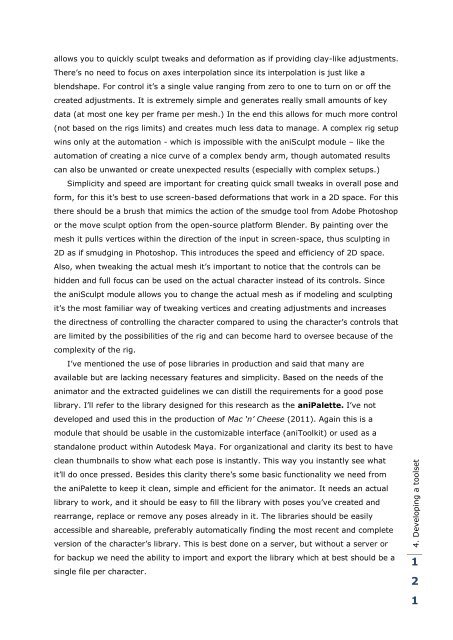Release. Pressure. Animate.
Release. Pressure. Animate.
Release. Pressure. Animate.
Create successful ePaper yourself
Turn your PDF publications into a flip-book with our unique Google optimized e-Paper software.
allows you to quickly sculpt tweaks and deformation as if providing clay-like adjustments.<br />
There‟s no need to focus on axes interpolation since its interpolation is just like a<br />
blendshape. For control it‟s a single value ranging from zero to one to turn on or off the<br />
created adjustments. It is extremely simple and generates really small amounts of key<br />
data (at most one key per frame per mesh.) In the end this allows for much more control<br />
(not based on the rigs limits) and creates much less data to manage. A complex rig setup<br />
wins only at the automation - which is impossible with the aniSculpt module – like the<br />
automation of creating a nice curve of a complex bendy arm, though automated results<br />
can also be unwanted or create unexpected results (especially with complex setups.)<br />
Simplicity and speed are important for creating quick small tweaks in overall pose and<br />
form, for this it‟s best to use screen-based deformations that work in a 2D space. For this<br />
there should be a brush that mimics the action of the smudge tool from Adobe Photoshop<br />
or the move sculpt option from the open-source platform Blender. By painting over the<br />
mesh it pulls vertices within the direction of the input in screen-space, thus sculpting in<br />
2D as if smudging in Photoshop. This introduces the speed and efficiency of 2D space.<br />
Also, when tweaking the actual mesh it‟s important to notice that the controls can be<br />
hidden and full focus can be used on the actual character instead of its controls. Since<br />
the aniSculpt module allows you to change the actual mesh as if modeling and sculpting<br />
it‟s the most familiar way of tweaking vertices and creating adjustments and increases<br />
the directness of controlling the character compared to using the character‟s controls that<br />
are limited by the possibilities of the rig and can become hard to oversee because of the<br />
complexity of the rig.<br />
I‟ve mentioned the use of pose libraries in production and said that many are<br />
available but are lacking necessary features and simplicity. Based on the needs of the<br />
animator and the extracted guidelines we can distill the requirements for a good pose<br />
library. I‟ll refer to the library designed for this research as the aniPalette. I‟ve not<br />
developed and used this in the production of Mac „n‟ Cheese (2011). Again this is a<br />
module that should be usable in the customizable interface (aniToolkit) or used as a<br />
standalone product within Autodesk Maya. For organizational and clarity its best to have<br />
clean thumbnails to show what each pose is instantly. This way you instantly see what<br />
it‟ll do once pressed. Besides this clarity there‟s some basic functionality we need from<br />
the aniPalette to keep it clean, simple and efficient for the animator. It needs an actual<br />
library to work, and it should be easy to fill the library with poses you‟ve created and<br />
rearrange, replace or remove any poses already in it. The libraries should be easily<br />
accessible and shareable, preferably automatically finding the most recent and complete<br />
version of the character‟s library. This is best done on a server, but without a server or<br />
for backup we need the ability to import and export the library which at best should be a<br />
single file per character.<br />
4. Developing a toolset<br />
1<br />
2<br />
1


